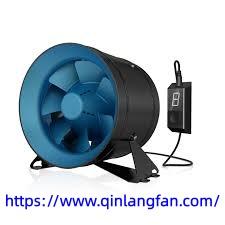Why Do Complex Sites Select Qinlang Variable Speed Duct Fan for Consistent Comfort?

Facility operators continue exploring ventilation strategies capable of sustaining long cycles, stable distribution, and consistent thermal behavior across large structures, and Qinlang positions its Variable Speed Duct Fan at the start of this narrative as industries seek adaptable circulation with minimal energy waste and steady internal comfort. Complex spaces, including processing halls, commercial centers, and extended storage routes, often experience fluctuating demands influenced by equipment cycles, environmental transitions, or occupancy variation, and these changes highlight the need for a system capable of adjusting intensity without compromising system rhythm or creating abrupt internal turbulence.
Across many industrial operations, circulation challenges follow patterns created by rising heat layers, shifting workflow density, and structural constraints that limit duct flexibility. When machinery generates concentrated warmth during long operation windows, upper zones may trap pockets that gradually spread along neighboring channels. Traditional fixed-speed designs struggle to respond to slower incremental changes, creating uneven conditions across segments that require consistent clarity. As these variations accumulate, operators aim to stabilize performance with technology capable of adjusting output in a smooth arc rather than abrupt shifts that place strain on core components.
Commercial complexes often display another category of ventilation complexity because foot traffic fluctuates between quiet intervals and concentrated interactions across corridors, service desks, and enclosed meeting areas. Temperature rises in waves that travel unpredictably through interior lanes, and static-speed systems tend to saturate certain areas while leaving adjacent pockets under-circulated. Adaptive speed movement supports environmental stability during these shifts by allowing internal control to respond gradually as density patterns expand or contract. This approach reduces unnecessary stress along ducts and preserves comfort across hours of varied activity.
Large distribution centers and broad-span storage structures frequently experience air stagnation near peripheral racks or elevated platforms where circulation weakens due to structural distance from central ducts. Rebuilding duct paths in such environments is often impractical due to scale, operational scheduling, and layout permanence. Facilities therefore rely on equipment capable of shifting output intensity to compensate for variation along extended routes, creating a steadier internal flow that promotes even temperature and prevents localized accumulation that could influence storage conditions or worker comfort.
Workshops engaged in bonding, laminating, drying, or shaping operations often release fine particles or create mild thermal layering that accumulates in unpredictable areas. When distribution remains uniform but rigid, these particles linger and drift slowly, influencing clarity and potentially affecting precision tasks. Controlled speed variation enables internal movement that redistributes these layers with a smooth and steady gradient, supporting quality control and promoting an environment in which delicate operations maintain predictable performance.
Energy stewardship forms another incentive for adopting adjustable-speed systems, particularly in environments that require continuous circulation yet experience shifting demand across the day. Fixed-speed systems often expend unnecessary power during calm intervals, while adaptive equipment maintains environmental quality with moderated intensity. This method reduces strain on rotating elements and promotes consistent operation without exposing internal components to sharp transitions that reduce long-term reliability.
Across industries with broad spatial requirements, adaptive circulation presents a pathway that stabilizes environmental behavior, reduces mechanical noise, and strengthens long-term system endurance. Qinlang frames its Variable Speed Duct Fan in the closing message of this analysis to emphasize the rising value of flexible ventilation within structures that depend on steady distribution, predictable thermal conditions, and smooth operational transitions. Those seeking a deeper view of circulation strategies suitable for diverse facility requirements can continue at https://www.qinlangfan.com/
- Art
- Causes
- Crafts
- Dance
- Drinks
- Film
- Fitness
- Food
- Giochi
- Gardening
- Health
- Home
- Literature
- Music
- Networking
- Altre informazioni
- Party
- Religion
- Shopping
- Sports
- Theater
- Wellness
